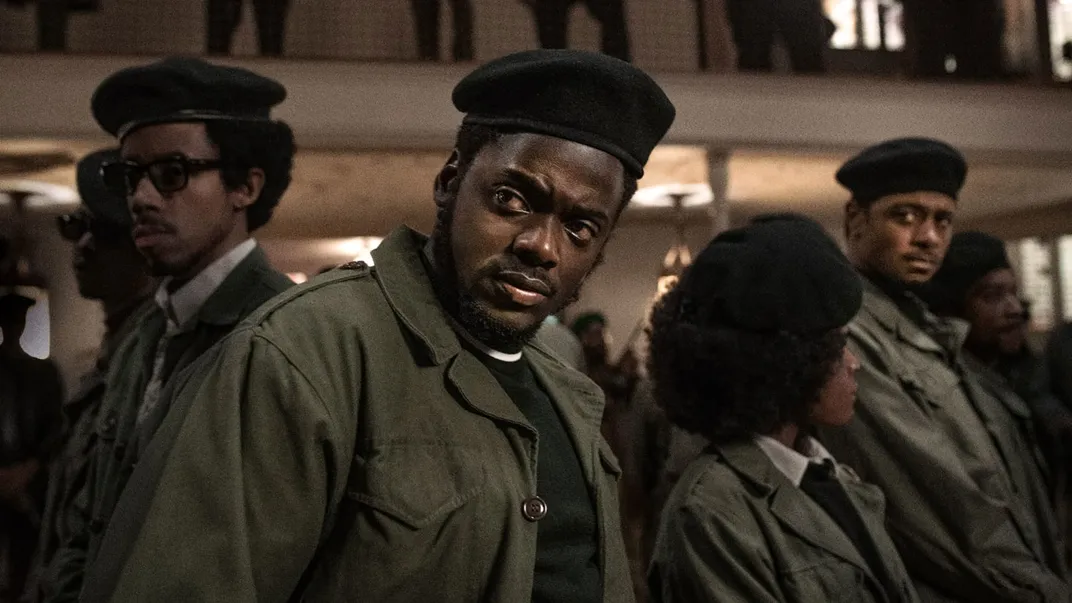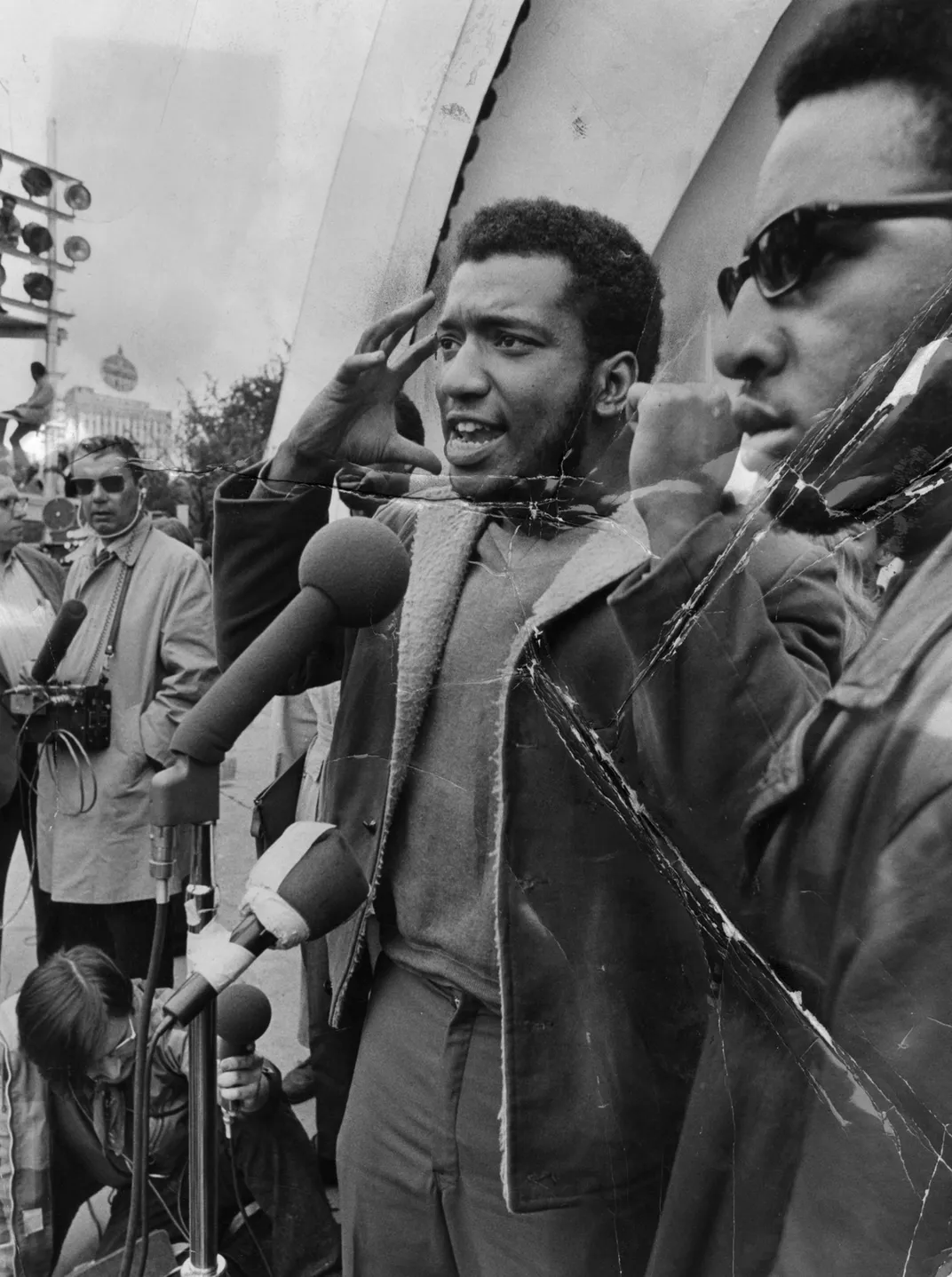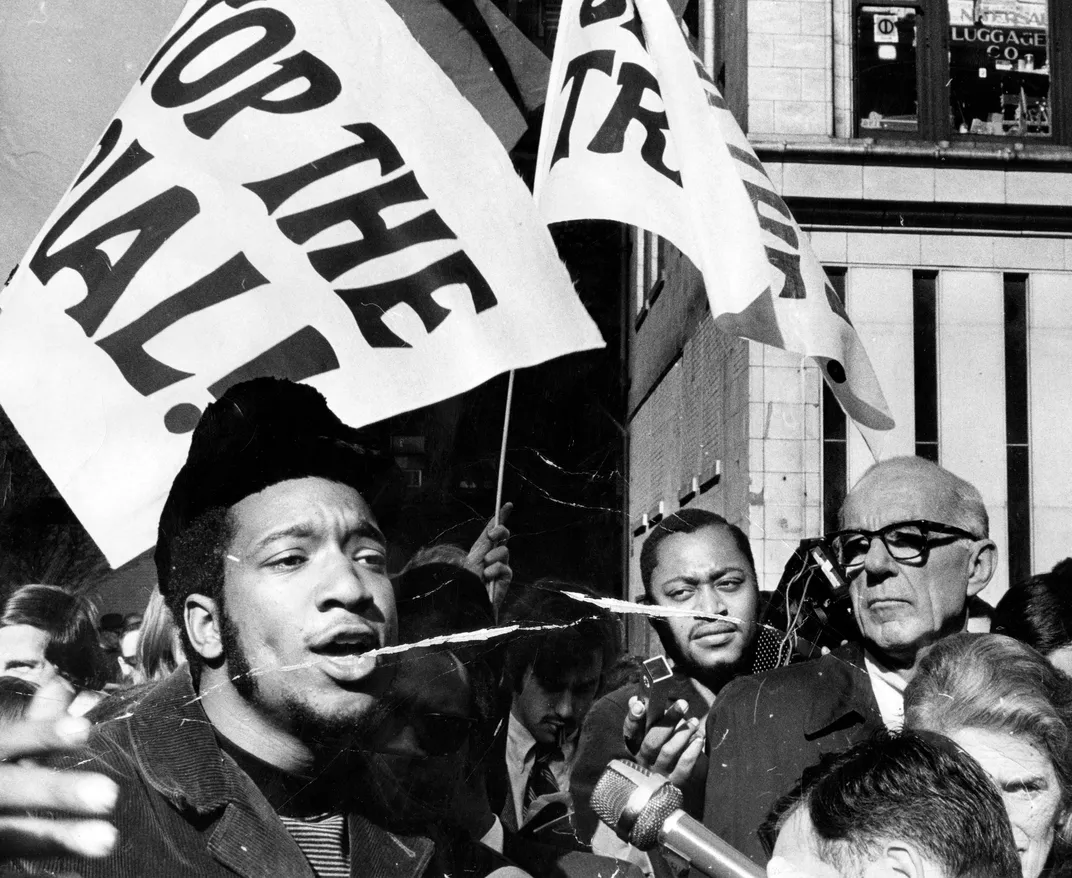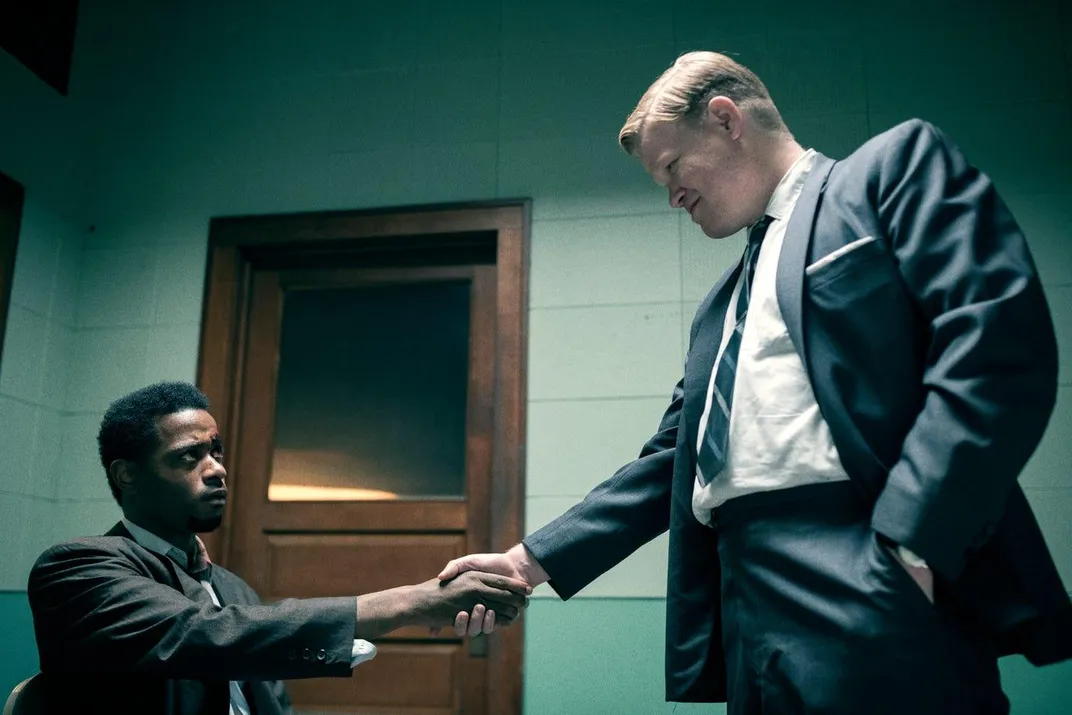When Chicago lawyer Jeffrey Haas first met Fred Hampton, chairman of the Illinois chapter of the Black Panther Party, he was struck by the 20-year-old activist’s “tremendous amount of energy” and charisma. It was August 1969, and Haas, 26 years old at the time, and his fellow attorneys at the People’s Law Office had just secured Hampton’s release from prison on trumped-up charges of stealing $71 worth of ice cream bars. To mark the occasion, Hampton delivered a speech at a local church, calling on the crowd to raise their right hand and repeat his words: “I am a revolutionary.”
“I couldn’t quite say that, because I thought I was a lawyer for the movement, but not necessarily of the movement,” recalls Haas, who is white. “But as Fred continued saying that, by the third or fourth time, I was shouting ‘I am a revolutionary’ like everyone else.”
Judas and the Black Messiah, a new film directed by Shaka King and co-produced by Black Panther director Ryan Coogler, deftly dramatizes this moment, capturing both Hampton’s oratorical prowess and the mounting injustices that led him and his audience to declare themselves revolutionaries. Starring Daniel Kaluuya of Get Out fame as the chairman, the movie chronicles the months preceding Hampton’s assassination in a December 1969 police raid, detailing his contributions to the Chicago community and dedication to the fight for social justice. Central to the narrative is the activist’s relationship with—and subsequent betrayal by—FBI informant William O’Neal (LaKeith Stanfield), who is cast as the Judas to Hampton’s “black messiah.”
“The Black Panthers are the single greatest threat to our national security,” says a fictionalized J. Edgar Hoover (Martin Sheen), echoing an actual assertion made by the FBI director, in the film. “Our counterintelligence program must prevent the rise of a black messiah.”
Here’s what you need to know to separate fact from fiction ahead of Judas and the Black Messiah’s debut in theaters and on HBO Max this Friday, February 12.
Is Judas and the Black Messiah based on a true story?
In short: yes, but with extensive dramatic license, particularly regarding O’Neal. As King tells the Atlantic, he worked with screenwriter Will Berson and comedians Kenny and Keith Lucas to pen a biopic of Hampton in the guise of a psychological thriller. Rather than focusing solely on the chairman, they opted to examine O’Neal—an enigmatic figure who rarely discussed his time as an informant—and his role in the FBI’s broader counterintelligence program, COINTELPRO.
“Fred Hampton came into this world fully realized. He knew what he was doing at a very young age,” says King. “Whereas William O’Neal is in a conflict; he’s confused. And that’s always going to make for a more interesting protagonist.”

Speaking with Deadline, the filmmaker adds that the crew wanted to move beyond Hampton’s politics into his personal life, including his romance with fellow activist Deborah Johnson (Dominique Fishback), who now goes by the name Akua Njeri.
“[A] lot of times when we think about these freedom fighters and revolutionaries, we don’t think about them having families … and plans for the future—it was really important to focus on that on the Fred side of things,” King tells Deadline. “On the side of O’Neal, [we wanted] to humanize him as well so that viewers of the film could leave the movie wondering, ‘Is there any of that in me?’”
Who are the film’s two central figures?
Born in a suburb of Chicago in 1948, Hampton demonstrated an appetite for activism at an early age. As Haas, who interviewed members of the Hampton family while researching his book, The Assassination of Fred Hampton: How the FBI and the Chicago Police Murdered a Black Panther, explains, “Fred just couldn’t accept injustice anywhere.” At 10 years old, he started hosting weekend breakfasts for other children from the neighborhood, cooking the meals himself in what Haas describes as a precursor to the Panthers’ free breakfast program. And in high school, he led walkouts protesting the exclusion of black students from the race for homecoming queen and calling on officials to hire more black teachers and administrators.
According to William Pretzer, a supervisory curator at the Smithsonian’s National Museum of African American History and Culture (NMAAHC), the young Hampton was keenly aware of racial injustice in his community. His mother babysat for Emmett Till prior to the 14-year-old’s murder in Mississippi in 1955; ten years after Till’s death, he witnessed white mobs attacking Martin Luther King Jr.’s Chicago crusade firsthand.
“Hampton is really influenced by the desire of the NAACP and King to make change, and the kind of resistance that they encounter,” says Pretzer. “So it’s as early as 1966 that Hampton starts to gravitate toward Malcolm X … [and his] philosophy of self-defense rather than nonviolent direct action.”

/https://tf-cmsv2-smithsonianmag-media.s3.amazonaws.com/filer/5e/f8/5ef84bee-a377-41bf-80d2-fc0aac7eb918/ek_jpijwwaief06.jpg)
After graduating from high school in 1966, Hampton, as president of the local NAACP Youth Chapter, advocated for the establishment of an integrated community pool and recruited upward of 500 new members. In large part due to his proven track record of successful activism, leaders of the burgeoning Black Panther Party recruited Hampton to help launch the movement in Chicago in November 1968. By the time of his death just over a year later, he’d risen to the rank of Illinois chapter chairman and national deputy chairman.
O’Neal, on the other hand, was a habitual criminal with little interest in activism before he infiltrated the Panthers at the behest of FBI agent Roy Mitchell (portrayed in the film by Jesse Plemons). As O’Neal recalled in a 1989 interview, Mitchell offered to overlook the-then teenager’s involvement in a multi-state car theft in exchange for intel on Hampton.
“[A] fast-talking, conniving West Side black kid who thought he knew all the angles,” O’Neal, according to the Chicago Tribune, joined the party and quickly won members’ admiration with his bravado, mechanical and carpentry skills, and willingness to place himself in the thick of the action. By the time of the police raid that killed Hampton, he’d been appointed the Panthers’ chief of security.
“Unlike what we might think of an informer being a quiet person who would appear to be a listener, O’Neal was out there all the time spouting stuff,” says Haas. “People were impressed by that. … He was a ‘go do it’ guy. 'I can fix this. I can get you money. I can do these kinds of things. And … that had an appeal for a while.”
Why did the FBI target Hampton?
Toward the beginning of Judas and the Black Messiah, Hoover identifies Hampton as a leader “with the potential to unite the Communist, the anti-war, and the New Left movements.” Later, the FBI director tells Mitchell that the black power movement’s success will translate to the loss of “[o]ur entire way of life. Rape, pillage, conquer, do you follow me?”
Once O’Neal is truly embedded within the Panthers, he discovers that the activists are not, in fact, “terrorists.” Instead, the informer finds himself dropped in the midst of a revolution that, in the words of co-founder Bobby Seale, was dedicated to “trying to make change in day-to-day lives” while simultaneously advocating for sweeping legislation aimed at achieving equality.
The Panthers’ ten-point program, penned by Seale and Huey P. Newton in 1966, outlined goals that resonate deeply today (“We want an immediate end to POLICE BRUTALITY and MURDER of Black people”) and others that were certain to court controversy (“We want all Black men to be exempt from military service” and “We want freedom for all Black men held in federal, state, county and city prisons and jails”). As Jeff Greenwald wrote for Smithsonian magazine in 2016, members “didn’t limit themselves to talk.” Taking advantage of California’s open-carry laws, for instance, beret-wearing Panthers responded to the killings of unarmed black Americans by patrolling the streets with rifles—an image that quickly attracted the condemnation of both the FBI and upper-class white Americans.

According to Pretzer, law enforcement viewed the Panthers and similar groups as a threat to the status quo. “They are focused on police harassment, … challenging the authority figures,” he says, “focusing on social activities that everybody thinks the government should be doing something about” but isn’t, like providing health care and ensuring impoverished Americans had enough to eat.
The FBI established COINTELPRO—short for counterintelligence program—in 1956 to investigate, infiltrate and discredit dissident groups ranging from the Communist Party of the United States to the Ku Klux Klan, the Nation of Islam and the Panthers. Of particular interest to Hoover and other top officials were figures like Martin Luther King Jr., Malcolm X and Hampton, many of whom endured illegal surveillance, explicit threats and police harassment. Details of the covert program only came to light in 1971, when activists stole confidential files from an FBI office in Pennsylvania and released them to the public.
Though Hampton stated that the Panthers would only resort to violence in self-defense, Hoover interpreted his words as a declaration of militant intentions.
“Because of COINTELPRO, because of the exacerbation, the harassment, the infiltration of these and agent provocateurs that they establish within these organizations, it’s a self-fulfilling prophecy from the FBI’s point of view,” Pretzer explains, “[in that] they get the violence they were expecting.”
As Haas and law partner Flint Taylor wrote for Truthout in January, newly released documents obtained through a Freedom of Information Act request confirm the lawyers’ long-held suspicion that Hoover himself was involved in the plan to assassinate Hampton.

What events does Judas and the Black Messiah dramatize?
Set between 1968 and 1969, King’s film spotlights Hampton’s accomplishments during his brief tenure as chapter chairman before delving into the betrayals that resulted in his death. Key to Hampton’s legacy were the Panthers’ survival programs, which sought to provide access to “fundamental elements of life,” per Pretzer. Among other offerings, the organization opened free health clinics, provided free breakfasts for children, and hosted political education classes that emphasized black history and self-sufficiency. (As Hampton said in 1969, “[R]eading is so important for us that a person has to go through six weeks of our political education before we can consider [them] a member.”)
On an average day, Hampton arrived at the Panthers’ headquarters with “a staccato of orders [that] gave energy to everyone around him,” says Haas. “But it wasn’t just what he asked people to do. He was there at 6:30 in the morning, making breakfast, serving the kids, talking to their parents.”
In addition to supporting these community initiatives—one of which, the free breakfast program, paved the way for modern food welfare policies—Hampton spearheaded the Rainbow Coalition, a boundary-crossing alliance between the Panthers, the Latino Young Lords, and the Young Patriots, a group of working-class white Southerners. He also brokered peace between rival Chicago gangs, encouraging them “to focus instead on the true enemy—the government and the police,” whom the Panthers referred to as “pigs,” according to the Village Free Press.
/https://tf-cmsv2-smithsonianmag-media.s3.amazonaws.com/filer/04/a7/04a72b70-f02c-4152-a66f-e3af65f6d941/gettyimages-72150265.jpg)
Speaking with Craig Phillips of PBS’ “Independent Lens” last year, historian Lilia Fernandez, author of Brown in the Windy City: Mexicans and Puerto Ricans in Postwar Chicago, explained, “The Rainbow Coalition presented a possibility. It gave us a vision for what could be in terms of interracial politics among the urban poor.”
Meanwhile, O’Neal was balancing his duties as an informant with his rising stature within the party. Prone to dramatic tendencies, he once built a fake electric chair intended, ironically, to scare informers. He also pushed the Panthers to take increasingly aggressive steps against the establishment—actions that led “more people, and Fred in particular, [to become] dubious of him,” says Haas.
The months leading up to the December 1969 raid found Hampton embroiled in legal troubles as tensions mounted between police and the Panthers. Falsely accused of theft and assault for the July 1968 ice cream truck robbery, he was denied bail until the People’s Law Office intervened, securing his release in August 1969. Between July and November of that year, authorities repeatedly clashed with the Panthers, engaging in shootouts that resulted in the deaths of multiple party members and police officers.
/https://tf-cmsv2-smithsonianmag-media.s3.amazonaws.com/filer/15/74/1574049d-0fe9-4255-8821-58507dd9f23b/screen_shot_2021-02-10_at_15907_pm.png)
By late November, the FBI, working off O’Neal’s intel, had convinced Cook County State’s Attorney Edward Hanrahan and the Chicago Police Department to raid Hampton’s home as he and his fiancée Johnson, who was nine months pregnant, slept. Around 4:30 a.m. on December 4, a heavily armed, 14-person raiding party burst into the apartment, firing upward of 90 bullets at the nine Panthers inside. One of the rounds struck and killed Mark Clark, a 22-year-old Panther stationed just past the front door. Though law enforcement later claimed otherwise, the physical evidence suggests that just one shot originated within the apartment.
Johnson and two other men tried to rouse the unconscious 21-year-old Hampton, who’d allegedly been drugged earlier that night—possibly by O’Neal, according to Haas. (O’Neal had also provided the cops with a detailed blueprint of the apartment.) Forced out of the bedroom and into the kitchen, Johnson heard a cop say, “He’s barely alive. He’ll barely make it.” Two shots rang out before she heard another officer declare, “He’s good and dead now.”
What happened after Hampton’s assassination?
Judas and the Black Messiah draws to a close shortly after the raid. In the film’s final scene, a conflicted O’Neal accepts an envelope filled with cash and agrees to continue informing on the Panthers. Superimposed text states that O’Neal remained with the party until the early 1970s, ultimately earning more than $200,000 when adjusted for inflation. After he was identified as the Illinois chapter’s mole in 1973, O’Neal received a new identity through the federal witness protection program. In January 1990, the 40-year-old, who’d by then secretly returned to Chicago, ran into traffic and was struck by a car. Investigators deemed his death a suicide.
“I think he was sorry he did what he did,” O’Neal’s uncle, Ben Heard, told the Chicago Reader after his nephew’s death. “He thought the FBI was only going to raid the house. But the FBI gave [the operation] over to the state's attorney and that was all Hanrahan wanted. They shot Fred Hampton and made sure he was dead.”
The attempt to uncover the truth about Hampton and Clark’s deaths began on the morning of December 4 and continues to this day. While one of Haas’ law partners went to the morgue to identify Hampton’s body, another took stock of the apartment, which the police had left unsecured. Haas, meanwhile, went to interview the seven survivors, four of whom had been seriously injured.
/https://tf-cmsv2-smithsonianmag-media.s3.amazonaws.com/filer/af/d8/afd8f7c2-4ef1-4508-8e63-1e0ecea802a1/screen_shot_2021-02-10_at_14653_pm.png)
Hanrahan claimed that the Panthers had opened fire on the police. But survivor testimony and physical evidence contradicted this version of events. “Bullet holes” ostensibly left by the Panthers’ shots were later identified as nail heads; blood stains found in the apartment suggested that Hampton was dragged out into the hallway after being shot in his bed at point-blank range.
Public outrage over the killings, particularly within the black community, grew as evidence discounting the authorities’ narrative mounted. As one elderly woman who stopped by the apartment to see the crime scene for herself observed, the attack “was nothing but a Northern lynching.”
Following the raid, Hanrahan charged the survivors with attempted murder. Haas and his colleagues secured Johnson’s release early enough to ensure she didn’t give birth to her son, Fred Hampton Jr., in jail, and the criminal charges were eventually dropped. But the attorneys, “not content with getting people off, decided we needed to file a civil suit” alleging a conspiracy to not only murder Hampton, but cover up the circumstances of his death, says Haas.
Over the next 12 years, Haas and his colleagues navigated challenges ranging from racist judges to defendants’ stonewalling, backroom deals between the FBI and local authorities, and even contempt charges brought against the attorneys themselves. Working from limited information, including leaked COINTELPRO documents, the team slowly pieced together the events surrounding the raid, presenting compelling evidence of the FBI’s involvement in the conspiracy.
/https://tf-cmsv2-smithsonianmag-media.s3.amazonaws.com/filer/b2/2d/b22d80cb-12a3-4e63-8bdc-21c31ce236d7/120139.jpg)
Though a judge dismissed the original case in 1977 following an 18-month trial, Haas and the rest of the team successfully appealed for a new hearing. In 1982, after more than a decade of protracted litigation, the defendants agreed to pay a settlement of $1.85 million to the nine plaintiffs, including Clark’s mother and Hampton’s mother, Iberia.
“I used to describe being in court like going to a dog fight every day,” says Haas. “Everything we would say would be challenged. The [defendants’ lawyers] would tell the jury everything the Panthers had ever been accused of in Chicago and elsewhere, and [the judge] would let them do that, but he wouldn't let us really cross examine the defendants.”
Hampton’s death dealt a significant blow to the Illinois chapter of the Black Panther Party, frightening members with its demonstration of law enforcement’s reach and depriving the movement of a natural leader.
According to Pretzer, “What comes out is that the the assassination of Hampton is a classic example of law enforcement’s malfeasance and overreach and ... provoking of violence.”
Today, says Haas, Hampton “stands as a symbol of young energy, struggle and revolution.”
The chairman, for his part, was keenly aware of how his life would likely end.
As he once predicted in a speech, “I don't believe I’m going to die slipping on a piece of ice; I don’t believe I’m going to die because I got a bad heart; I don’t believe I’m going to die because of lung cancer. I believe that I’m going to be able to die doing the things I was born for. ... I believe that I will be able to die as a revolutionary in the international revolutionary proletarian struggle.”
:focal(311x105:312x106)/https://tf-cmsv2-smithsonianmag-media.s3.amazonaws.com/filer/8d/ed/8ded56c2-7739-43da-a1f9-c8d3da683319/mobile_fred.jpg)
:focal(588x188:589x189)/https://tf-cmsv2-smithsonianmag-media.s3.amazonaws.com/filer/9e/12/9e12c8e5-03b5-41b9-a576-e1a7720fde0b/chairman_fred_social.jpg)
/https://tf-cmsv2-smithsonianmag-media.s3.amazonaws.com/accounts/headshot/mellon.png)


/https://tf-cmsv2-smithsonianmag-media.s3.amazonaws.com/accounts/headshot/mellon.png)